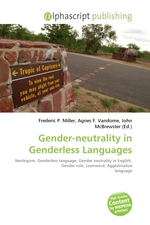Gender-neutrality in Genderless Languages
Frederic P. Miller, Agnes F. Vandome, John McBrewster
бумажная книга
High Quality Content by WIKIPEDIA articles! Gender neutrality in genderless languages is typically achieved by using gender-inclusive words ("human being", "person", "businessperson", and so on) instead of gender-specific ones ("man", "he", "businessman", etc.) when one speaks of people whose gender is unknown, ambiguous, or unimportant. When only a gender-specific word happens to be available, a gender-inclusive neologism may be coined to replace it. Estonian word ta (or tema) is gender-neutral and means both "she" and "he". The suffix -tar or -nna can be added to the end of some words (mostly professions) to make them feminine, although these nouns are in their basic form gender-neutral: laulja (singer), lauljatar (female singer) or lauljanna (female singer); naitleja (actor) - naitlejanna (actress) or naitlejatar (actress). This is rather common.
Данное издание не является оригинальным. Книга печатается по технологии принт-он-деманд после получения заказа.


